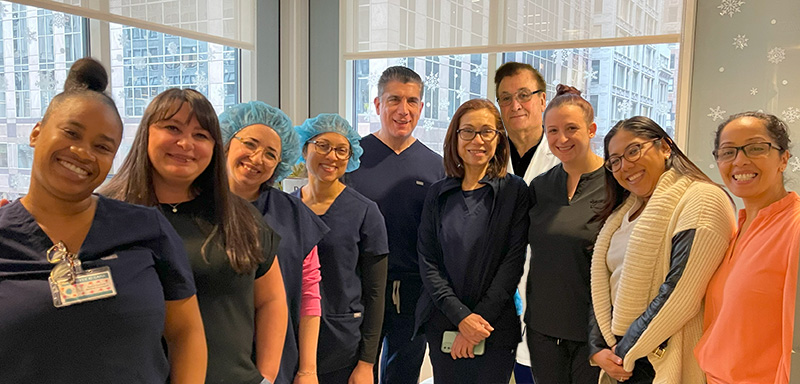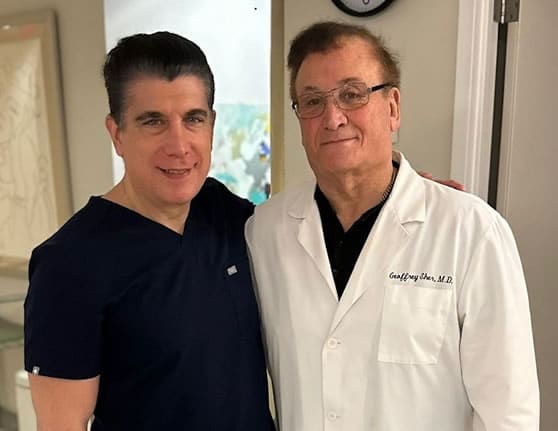Answer:
I really sympathize with your predicament but there is no substitute for an appropriate and comprehensive medical evaluation of your problem….especially when it comes to an evaluation of immunologic implantation dysfunction.
I urge you to download a free copy of my E-book , “Recurrent Pregnancy Loss and Unexplained IVF Failure: The Immunologic Link”, by clicking on: :https://drive.google.com/file/d/1iYKz-EkAjMqwMa1ZcufIloRdxnAfDH8L/view
When it comes to reproduction, humans are the poorest performers of all mammals. In fact we are so inefficient that up to 75% of fertilized eggs do not produce live births, and up to 30% of pregnancies end up being lost within 10 weeks of conception (in the first trimester). RPL is defined as two (2) or more failed pregnancies. Less than 5% of women will experience two (2) consecutive miscarriages, and only 1% experience three or more.
Pregnancy loss can be classified by the stage of pregnancy when the loss occurs:
- Early pregnancy loss (first trimester)
- Late pregnancy loss (after the first trimester)
- Occult “hidden” and not clinically recognized, (chemical) pregnancy loss (occurs prior to ultrasound confirmation of pregnancy)
- Early pregnancy losses usually occur sporadically (are not repetitive).
In more than 70% of cases the loss is due to embryo aneuploidy (where there are more or less than the normal quota of 46 chromosomes). Conversely, repeated losses (RPL), with isolated exceptions where the cause is structural (e.g., unbalanced translocations), are seldom attributable to numerical chromosomal abnormalities (aneuploidy). In fact, the vast majority of cases of RPL are attributable to non-chromosomal causes such as anatomical uterine abnormalities or Immunologic Implantation Dysfunction (IID).
Since most sporadic early pregnancy losses are induced by chromosomal factors and thus are non-repetitive, having had a single miscarriage the likelihood of a second one occurring is no greater than average. However, once having had two losses the chance of a third one occurring is double (35-40%) and after having had three losses the chance of a fourth miscarriage increases to about 60%. The reason for this is that the more miscarriages a woman has, the greater is the likelihood of this being due to a non-chromosomal (repetitive) cause such as IID. It follows that if numerical chromosomal analysis (karyotyping) of embryonic/fetal products derived from a miscarriage tests karyotypically normal, then by a process of elimination, there would be a strong likelihood of a miscarriage repeating in subsequent pregnancies and one would not have to wait for the disaster to recur before taking action. This is precisely why we strongly advocate that all miscarriage specimens be karyotyped.
There is however one caveat to be taken into consideration. That is that the laboratory performing the karyotyping might unwittingly be testing the mother’s cells rather than that of the conceptus. That is why it is not possible to confidently exclude aneuploidy in cases where karyotyping of products suggests a “chromosomally normal” (euploid) female.
Late pregnancy losses (occurring after completion of the 1st trimester/12th week) occur far less frequently (1%) than early pregnancy losses. They are most commonly due to anatomical abnormalities of the uterus and/or cervix. Weakness of the neck of the cervix rendering it able to act as an effective valve that retains the pregnancy (i.e., cervical incompetence) is in fact one of the commonest causes of late pregnancy loss. So also are developmental (congenital) abnormalities of the uterus (e.g., a uterine septum) and uterine fibroid tumors. In some cases intrauterine growth retardation, premature separation of the placenta (placental abruption), premature rupture of the membranes and premature labor can also causes of late pregnancy loss.
Much progress has been made in understanding the mechanisms involved in RPL. There are two broad categories:
- Problems involving the uterine environment in which a normal embryo is prohibited from properly implanting and developing. Possible causes include:
- Inadequate thickening of the uterine lining
- Irregularity in the contour of the uterine cavity (polyps, fibroid tumors in the uterine wall, intra-uterine scarring and adenomyosis)
- Hormonal imbalances (progesterone deficiency or luteal phase defects). This most commonly results in occult RPL.
- Deficient blood flow to the uterine lining (thin uterine lining).
- Immunologic implantation dysfunction (IID). A major cause of RPL. Plays a role in 75% of cases where chromosomally normal preimplantation embryos fail to implan
- Interference of blood supply to the developing conceptus can occur due to a hereditary clotting disorder known as Thrombophili
- Genetic and/or numerical chromosomal abnormalities(aneuploidy) of the embryo are far away the commonest overall causes of miscarriages. But this only applies to sporadic pregnancy losses (which comprises the majority of all miscarriages. However, recurrent, (consecutive) pregnancy losses are much more likely due to implantation dysfunction than to embryo-related issues, where implantation dysfunction (usually anatomical or immunologic) factors usually underly the problem.
- Genetic or Structural chromosomal abnormalities (which only occur in about 1% of cases) can also cause RPL. This is referred to as an unbalanced translocation and they result from part of one chromosome detaching and then fusing with another chromosome. Additionally, genetic defects (unrelated to chromosomal abnormalities) can also affect embryo quality and pregnancy outcome. Damaged sperm DNA can sometimes be diagnosed using the SCSA (see before) which primarily measures the sperm DNA fragmentation index (DFI).
IMMUNOLOGIC IMPLANTATION DYSFUNCTIO-IID (see before)
Autoimmune IID: Here an immunologic reaction is produced by the individual to his/her body’s own cellular components. The most common antibodies that form in such situations are APA and antithyroid antibodies
Alloimmune IID, i.e., where there is an immunologic reaction to antigens derived from another member of the same species (i.e. the woman’s immune system reacts to the paternal antigens in the sperm (see above) .
*It is important to recognize that alloimmune (rather than autoimmune) IID is more commonly associated with RPL.
Autoimmune IID is often genetically transmitted. Thus, it should not be surprising to learn that it is more likely to exist in women who have a family (or personal) history of primary autoimmune diseases such as lupus erythematosus (LE), scleroderma or autoimmune hypothyroidism (Hashimoto’s disease), autoimmune hyperthyroidism (Grave’s disease), rheumatoid arthritis, etc. Reactionary (secondary) autoimmunity can occur in conjunction with any medical condition associated with widespread tissue damage. One such gynecologic condition is endometriosis. Since autoimmune IID is usually associated with activated NK and T-cells from the outset, it usually results in such very early destruction of the embryo’s root system that the patient does not even recognize that she is pregnant. Accordingly, the condition usually presents as “unexplained infertility” or “unexplained IVF failure” rather than as a miscarriage.
Alloimmune IID, on the other hand, usually starts off presenting as unexplained miscarriages (often manifesting as RPL). Over time as NK/T cell activation builds and eventually becomes permanently established the patient often goes from RPL to “infertility” due to failed implantation. RPL is more commonly the consequence of alloimmune rather than autoimmune implantation dysfunction.
However, regardless, of whether miscarriage is due to autoimmune or alloimmune implantation dysfunction the final blow to the pregnancy is the result of activated NK cells and CTL in the uterine lining that damage the developing embryo’s “root system” (trophoblast) so that it can no longer sustain the growing conceptus. This having been said, it is important to note that autoimmune IID is readily amenable to reversal through timely, appropriately administered, selective immunotherapy, and alloimmune IID is not. It is much more difficult to treat successfully, even with the use of immunotherapy. In fact, in some cases the only solution will be to revert to selective immunotherapy plus using donor sperm (provided there is no “match” between the donor’s DQ alpha/HLA profile and that of the female recipient) or alternatively to resort to gestational surrogacy.
DIAGNOSING THE CAUSE OF RPL
In the past, women who miscarried were not evaluated thoroughly until they had lost several pregnancies in a row. This was because sporadic miscarriages are most commonly the result of embryo numerical chromosomal irregularities (aneuploidy) and thus not treatable. However, a consecutive series of miscarriages points to a repetitive cause that is non-chromosomal and is potentially remediable. Since RPL is most commonly due to a uterine pathology or immunologic causes that are potentially treatable, it follows that early chromosomal evaluation of products of conception could point to a potentially treatable situation. Thus, we strongly recommend that such testing be done in most cases of miscarriage. Doing so will avoid a great deal of unnecessary heartache for many patients.
Establishing the correct diagnosis is the first step toward determining effective treatment for couples with RPL. It results from a problem within the pregnancy itself or within the uterine environment where the pregnancy implants and grows. Diagnostic tests useful in identifying individuals at greater risk for a problem within the pregnancy itself include:
- Karyotyping (chromosome analysis) both prospective parents
- Assessment of the karyotype of products of conception derived from previous miscarriage specimens
- Ultrasound examination of the uterine cavity after sterile water is injected or sonohysterogram, fluid ultrasound, etc.
- Hysterosalpingogram (dye X-ray test)
- Hysteroscopic evaluation of the uterine cavity
- Full hormonal evaluation (estrogen, progesterone, adrenal steroid hormones, thyroid hormones, FSH/LH, )
- Immunologic testing to include:
- Antiphospholipid antibody (APA) panel
- Antinuclear antibody (ANA) panel
- Antithyroid antibody panel (i.e., antithyroglobulin and antimicrosomal antibodies)
- Reproductive immunophenotype
- Natural killer cell activity (NKa) assay (i.e., K562 target cell test)
- Alloimmune (DQ alpha/HLA) testing of both the male and female partners
TREATMENT OF RPL
Treatment for Anatomic Abnormalities of the Uterus: This involves restoration through removal of local lesions such as fibroids, scar tissue, and endometrial polyps or timely insertion of a cervical cerclage (a stitch placed around the neck of the weakened cervix) or the excision of a uterine septum when indicated.
Treatment of Thin Uterine Lining: A thin uterine lining has been shown to correlate with compromised pregnancy outcome. Often this will be associated with reduced blood flow to the endometrium. Such decreased blood flow to the uterus can be improved through treatment with sildenafil and possibly aspirin.
Sildenafil (Viagra) Therapy (see above). Viagra has been used successfully to increase uterine blood flow. To date, we have seen significant improvement of the thickness of the uterine lining in about 70% of women treated. Successful pregnancy resulted in almost half of those women who responded to the Viagra. It should be borne in mind that most of these women had previously experienced repeated IVF failures.
Use of Aspirin: This is an anti-prostaglandin that improves blood flow to the endometrium. It is administered at a dosage of 81 mg orally, daily from the beginning of the cycle until ovulation.
Treating Immunologic Implantation Dysfunction with Selective Immunotherapy: Modalities such as IL/IVIg, heparinoids (Lovenox/Clexane), and corticosteroids can be used in select cases depending on autoimmune or alloimmune dysfunction.
The Use of IVF in the Treatment of RPL. In the following circumstances, IVF is the preferred option:
- When in addition to a history of RPL, another standard indication for IVF (e.g., tubal factor, endometriosis, and male factor infertility) is superimposed.
- In cases where selective immunotherapy is needed to treat an immunologic implantation dysfunction.
The reason for IVF being a preferred approach in such cases is that in order to be effective, the immunotherapy needs to be initiated well before spontaneous or induced ovulation. Given the fact that in the absence of IVF the anticipated birthrate per cycle of COS with or without IUI is at best about 15%, it follows that short of IVF, to have even a reasonable chance of a live birth, most women with immunologic causes of RPL would need to undergo immunotherapy repeatedly, over consecutive cycles. Conversely, with IVF, the chance of a successful outcome in a single cycle of treatment is several times greater and, because of the attenuated and concentrated time period required for treatment, IVF is far safer and thus represents a more practicable alternative
Since embryo aneuploidy is a common cause of miscarriage, the use of PGS/PGT-A can provide a valuable diagnostic and therapeutic advantage in cases of RPL. PGD requires IVF to provide access to embryos for testing.
There are a few cases of intractable alloimmune dysfunction due to “complete DQ alpha matching where Gestational Surrogacy or use of Donor Sperm could represent the only viable recourse, other than abandoning treatment altogether and/or resorting to adoption. Other non-immunologic factors such as an intractably thin uterine lining or severe uterine pathology might also warrant that last resort consideration be given to gestational surrogacy.
The good news is that if a couple with RPL is open to all of the diagnostic and treatment options referred to above, a live birthrate of 70%–80% is ultimately achievable.
I strongly recommend that you visit www.SherIVF.com. Then go to my Blog and access the “search bar”. Type in the titles of any/all of the articles listed below, one by one. “Click” and you will immediately be taken to those you select. Please also take the time to post any questions or comments with the full expectation that I will (as always) respond promptly.
- The IVF Journey: The importance of “Planning the Trip” Before Taking the Ride”
- Controlled Ovarian Stimulation (COS) for IVF: Selecting the ideal protocol
- IVF: Factors Affecting Egg/Embryo “competency” during Controlled Ovarian Stimulation(COS)
- The Fundamental Requirements For Achieving Optimal IVF Success
- Ovarian Stimulation for IVF using GnRH Antagonists: Comparing the Agonist/Antagonist Conversion Protocol.(A/ACP) With the “Conventional” Antagonist Approach
- Ovarian Stimulation in Women Who have Diminished Ovarian Reserve (DOR): Introducing the Agonist/Antagonist Conversion protocol
- Anti Mullerian Hormone (AMH) Measurement to Assess Ovarian Reserve and Design the Optimal Protocol for Controlled Ovarian Stimulation (COS) in IVF.
- Human Growth Hormone Administration in IVF: Does it Enhances Egg/Embryo Quality and Outcome?
- The BCP: Does Launching a Cycle of Controlled Ovarian Stimulation (COS). Coming off the BCP Compromise Response?
- Blastocyst Embryo Transfers Should be the Standard of Care in IVF
- IVF: How Many Attempts should be considered before Stopping?
- “Unexplained” Infertility: Often a matter of the Diagnosis Being Overlooked!
- IVF Failure and Implantation Dysfunction:
- The Role of Immunologic Implantation Dysfunction (IID) & Infertility (IID):PART 1-Background
- Immunologic Implantation Dysfunction (IID) & Infertility (IID):PART 2- Making a Diagnosis
- Immunologic Dysfunction (IID) & Infertility (IID):PART 3-Treatment
- Thyroid autoantibodies and Immunologic Implantation Dysfunction (IID)
- Immunologic Implantation Dysfunction: Importance of Meticulous Evaluation and Strategic Management:(Case Report
- Intralipid and IVIG therapy: Understanding the Basis for its use in the Treatment of Immunologic Implantation Dysfunction (IID)
- Intralipid (IL) Administration in IVF: It’s Composition; How it Works; Administration; Side-effects; Reactions and Precautions
- Natural Killer Cell Activation (NKa) and Immunologic Implantation Dysfunction in IVF: The Controversy!
- Endometrial Thickness, Uterine Pathology and Immunologic Factors
- Vaginally Administered Viagra is Often a Highly Effective Treatment to Help Thicken a Thin Uterine Lining
- Treating Out-of-State and Out-of-Country Patients at Sher-IVF in Las Vegas:
- A personalized, stepwise approach to IVF
- How Many Embryos should be transferred: A Critical Decision in IVF.
- The Role of Nutritional Supplements in Preparing for IVF
______________________________________________________
ADDENDUM: PLEASE READ!!
INTRODUCING SHER FERTILITY SOLUTIONS (SFS)
Founded in April 2019, Sher Fertility Solutions (SFS) offers online (Skype/FaceTime) consultations to patients from > 40 different countries. All consultations are followed by a detailed written report presenting my personal recommendations for treatment of what often constitute complex Reproductive Issues.
If you wish to schedule an online consultation with me, please contact my assistant (Patti Converse) by phone (800-780-7437/702-533-2691), email (concierge@SherIVF.com) or, enroll online on then home-page of my website (www.SherIVF.com).
PLEASE SPREAD THE WORD ABOUT SFS!
Geoff Sher








